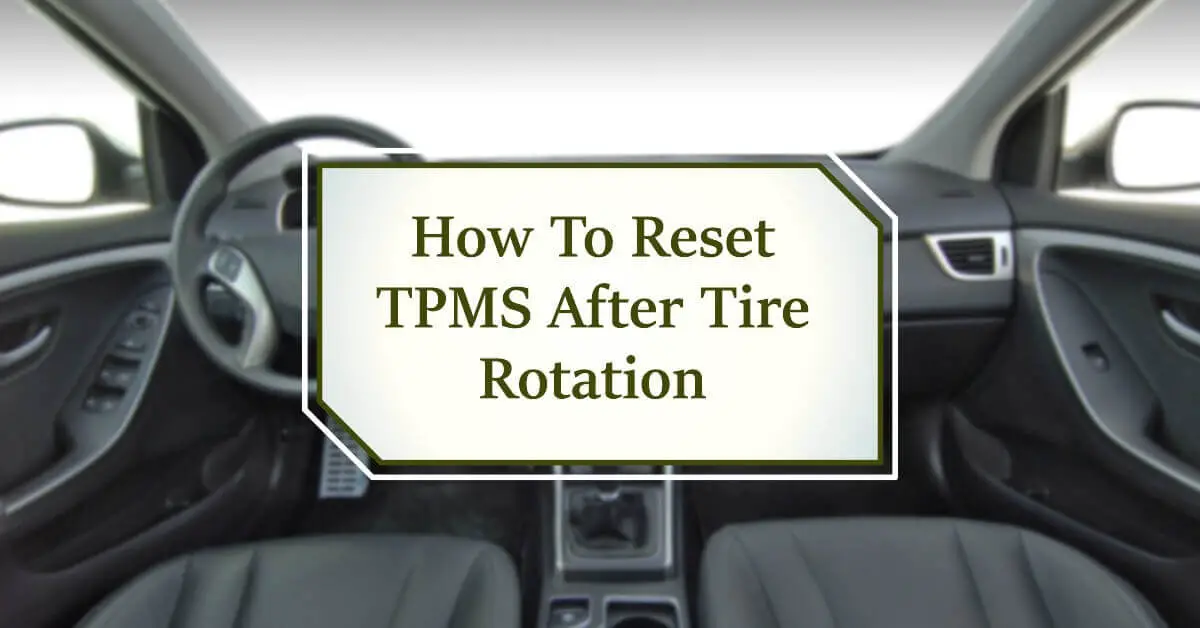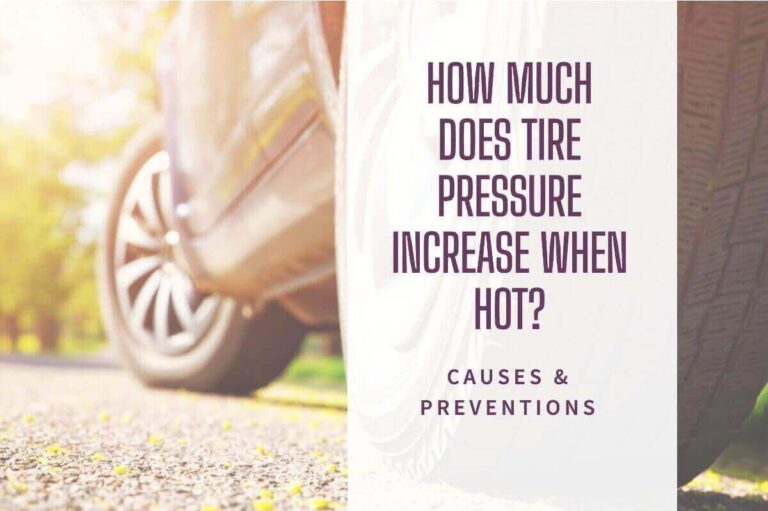Tire pressure monitoring systems (TPMS) are an essential feature of all modern cars. They are designed to alert you when your tire pressure is low and let you know when it’s time to rotate tires.
But what happens if you forget to reset the TPMS after a rotation? In this article, we’ll be discussing how to reset TPMS after tire rotation so that you can keep your car running smoothly.
How To Reset TPMS After Tire Rotation
Tire rotation is an important part of vehicle maintenance, which you should do periodically. But after each rotation, it’s essential to reset your Tire Pressure Monitoring System (TPMS) to ensure proper tire pressure readings.
If you’re a car owner, you know it’s important to rotate your car tires regularly. It is because the wear from driving can cause the tread of your tires to become uneven. If left untreated, this can lead to dangerous handling and a loss of grip on the road.
We’ll walk you through the simple process of resetting TPMS after each tire rotation. We’ll explain how to reset TPMS after tire rotation, why it is so essential, and the precautions you should take to avoid damage.
Tools Needed for Resetting TPMS
A Tire Pressure Monitoring System (TPMS) is a feature in many modern cars that helps drivers keep their car tires inflated to the proper levels.
Resetting your TPMS after a tire rotation is an important step for properly maintaining your vehicle, and there are several tools needed to ensure that it happens smoothly.
The main tool used for resetting TPMS is a scan tool, which can be bought at any automotive store. This device plugs into the vehicle’s diagnostic port and sends signals to the car’s computer system to activate or deactivate certain features, such as TPMS.
Another essential item you will need is a torque wrench and flathead screwdriver, which will help you ensure that all of your lug nuts are tightened properly while installing the new tires.
Step 1: Locate the Valve Stem
If you are looking for how to reset TPMS after tire rotation, the first step is locating the valve stem on each of your tires. It is typically found on the inside wall of your wheel and can be identified by its small cap.
Carefully remove this cap with a flathead screwdriver or similar tool, then locate the valve stem underneath it. The valve stem should look like a short metal tube with an angled tip.
Step 2: Activate the Reset Mode
You must activate the reset mode in order to ensure that your TPMS is functioning correctly and providing accurate readings.
Doing this can help protect against over-inflation or under-inflation of your tires, which can lead to decreased fuel efficiency, increased wear and tear on your tires, and unsafe driving conditions.
Two main methods for activating the reset mode are manually or via a scan tool.
- Manually activating the reset mode involves pressing a button near most vehicles’ steering wheels; consult your owner’s manual for detailed instructions specific to your model.
- Scanning tools are available at most auto stores or online, providing more detailed information about tire pressure and ways to reset the TPMS when necessary.
Step 3: Follow Sensor Specifics
Step 3 is about following the specific instructions outlined by the sensor manufacturer. Depending on your vehicle and its installed TPMS, there may be different directions for reset implementation.
First and foremost, you should check with your user manual or service technician to get the most up-to-date information regarding your particular TPMS system.
If this is not available to you, use caution when resetting the device yourself. While some steps may be universal across all models and make of vehicles, many require unique approaches to complete the reset effectively.
Step 4: Check Tire Pressure
Having your tires rotated is a great way to extend the life of your vehicle and ensure that you are always driving safely.
After having your tires rotated, it is important to check the tire pressure in each tire to make sure it is properly inflated. This fourth step in resetting TPMS after a tire rotation will help you maintain proper performance and fuel efficiency.
When checking the tire pressure, make sure that each tire’s pressure reading matches its recommended psi (pounds per square inch).
To find out what this number should be, refer to either the manufacturer’s manual or look for a sticker inside the driver’s door frame of the car. Once you have checked each tire pressure, adjust them accordingly if needed by using a manual or digital air pump.
Step 5: Finish Reset Process
Step 5 of the reset process is to finish the reset process and get your car back on the road. First, make sure all four wheels are inflated to their recommended PSI (pounds per square inch). It can be found in a variety of places, including your car manual, inside your fuel door, or from a tire shop.
Next, drive around for about 10-15 minutes so the TPMS can relearn and adjust to the new wheel positions. After this time has passed, you should see all four-wheel pressure readings displayed on your dashboard or instrument panel; this indicates that it has successfully been how to reset TPMS after tire rotation.
Safety Precautions
There are several safety precautions to keep in mind while resetting the tire pressure monitoring system (TPMS):
- Before resetting the TPMS, ensure the tire pressure is at the correct level. You can find the recommended tire pressure in the owner’s manual or on a sticker inside the fuel filler door or driver’s side doorjamb.
- When resetting the TPMS, wear protective gear such as gloves and eye protection. It will help protect you from any debris or chemicals that may be present in the tire.
- To reset the TPMS, you will need access to the vehicle’s computer and control module. Ensure you have the proper tools, such as a scan tool or a TPMS reset tool, before attempting to reset the system.
- Before resetting the TPMS, ensure you understand the instructions for your specific vehicle make and model. Some vehicles require special procedures or tools to reset the TPMS.
- TPMS reset procedures can be complex, so take your time and follow the instructions carefully. If you are unsure how to reset the TPMS, consider having a professional do it.
By following these safety precautions, you can ensure how to reset TPMS after a tire rotation process is performed correctly and safely, helping to keep you and your vehicle safe on the road.
Why Resetting TPMS Important
It is important to reset the tire pressure monitoring system (TPMS) after a tire rotation because it ensures that it accurately reflects your vehicle’s current tire pressure.
TPMS is a safety feature that alerts you when the tire pressure is too low or high, which can result in poor handling and increased fuel consumption.
If you change your tires, rotate them, or add air to the tires, the TPMS sensor inside each tire may not accurately reflect the current tire pressure. In this case, resetting the TPMS is necessary to calibrate the system and ensure it functions properly.
Conclusion – How To Reset TPMS After Rotation
It’s important to check your tire pressure regularly, including after you rotate your tires. But after rotating your tires, it’s also important to reset the TPMS (Tire Pressure Monitoring System).
Resetting the TPMS ensures that the system is accurate and functioning correctly. Doing this will also give you an accurate reading of your tire pressure to ensure that your tires are properly inflated.
Silverado or Honda TPMS after tire rotation, resetting is an important step to ensuring your safety on the road. You need to reset the TPMS to receive accurate tire pressure readings and avoid being at risk for under-inflated tires.
This guide on how to reset TPMS after tire rotation was helpful, and you learned something new about TPMS.
FAQs
How To Rotate Tires With TPMS?
To rotate tires with TPMS, check tire pressure, mark the tire position, remove tires, move them to the next wheel position in a cross pattern, reinstall tires, reset the TPMS system if necessary, and finally, check the tire pressure again.
Do You Need To Reset TPMS After Tire Rotation?
Yes, you usually need to reset the TPMS after rotating the tires because the sensors are located in the wheels and tires, and their positions change when the tires are moved. Resetting the TPMS allows the system to monitor tire pressure again accurately. The method to reset the TPMS depends on the vehicle’s make and model and can be done with an onboard reset tool, a TPMS reset tool, or by visiting a dealership.
What Can Happen If TPMS Systems Are Not Reset After Tire Rotation?
If the TPMS is reset after rotating tires, it can lead to accurate tire pressure readings, an illuminated TPMS warning light, and incorrect tire pressure. It can negatively impact vehicle performance, handling, and safety.








